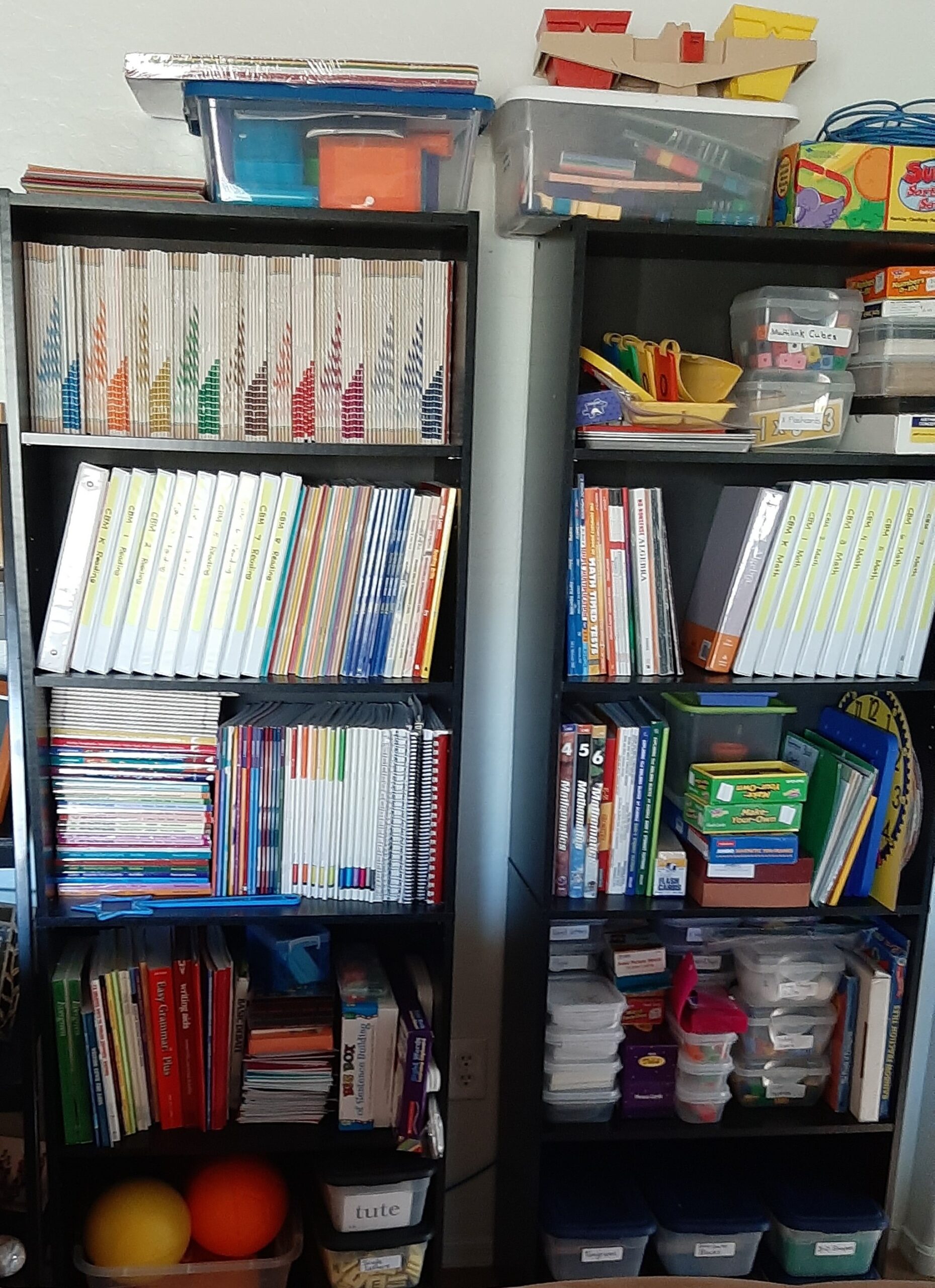In the last article, I shared my list of student homeschool supplies. The supplies on my teacher list are for materials that I use in the planning, preparation, and managing of our homeschool. I am sharing my full list of things I use each year. Some of them are for younger kids and some are for older grades.
As you read through the list, you may want to keep a wish list if items are too expensive for right now as you are getting started. If you are new to homeschooling, you don’t need all of these at once. You can always add things as you need them.
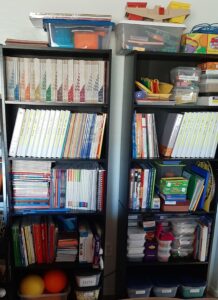
OK. Here’s my Teacher Supply List.
Organizational Supplies
- Bookshelves. A homeschool mom can never have too many bookcases. I found the 5 shelves bookcases from discount stores were adequate, and I could afford to have plenty. Of course, you can get similar ones from Target, Ikea, and other places. For many years, I used white, then wood color. Since we moved, I’ve been getting black so they will look a bit more trendy and less dingy. I just liked all mine to be the same size and style to make our library look a little more organized than having a mishmash. That’s up to you. Many times you can pick up bookshelves at moving/garage sales or thrift stores.
- A Large Storage Containers.
- Over the years, I have used plastic storage buckets with lids, dorm/milk crates, plastic dishwashing buckets without lids, separated cubbies without buckets, separated cubbies with cloth covered boxes, trapper keepers, plastic file boxes with flip lids, and probably others that I can’t recall at the moment. Take a look at the different options, and decide what works best for your space and your children’s needs at this time.
- Why did I use so many different systems? First, my kids changed each year as they grew, so some years I needed the storage for all the toys and manipulatives. Later, I needed boxes for each kid to keep their own supplies.
- The changes were also to keep things fresh, match the area where we planned to keep our supplies, and give the kids independence in having free access to their own supplies. Advice: The more limited your overall space, the more organized you need to be so that supplies don’t get lost and the clutter is contained.
- Plastic Organizational Drawers. Plastic organizational drawers help for storing supplies, creating task boxes, keeping individual kids work, and for creating systems for kids to get supplies and return them.
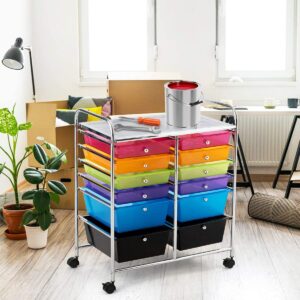
- Square or Rectangular Baskets. – If you use a relaxed Charlotte Mason, Montessori, or Reggio Emilia approach, square and rectangular baskets made of natural materials both wood and metal, can create lovely presentations for activities. I also keep a book basket or two around the house for kids to pick up a book whenever they feel like it. HINT: Find used ones at thrift stores and garage sales to save money!
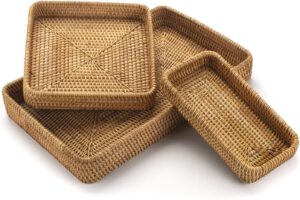
- Labels.
- Plastic sheet cutting boards or placemats for keeping messy art projects in control.
- Shower Curtain Liners. Shower liners are great as drop cloths for painting projects and for putting out Legos or building kits for easy clean up!
- Plastic Containers with Lids.
- I keep supplies in shoebox containers with everything labeled. If you plan to do task boxes or sensory bins, you will need plastic containers also.
- I also use lunch sandwich plastic containers because they are often just the right size for task cards.
- I have used smaller plastic food storage containers for organizing beads, wiggly eyes, jingle bells, and so many of those little crafting supplies. I prefer ones that are clear so I can see what is in each one, but they are also marked with labels.
- Plastic Sandwich, Quart, and Gallon Ziplock Bags – I mainly use these for storing individual sets of letter and number cards in larger plastic containers. I also use them for storing game pieces, home-made play dough or slime, and much more.
Office Supplies
- A Good Printer. I prefer HP printers. I find them reliable and compatible with my hp computers. If you have different preferences, that’s just fine!
- My favorite is the HP All-in-One Officejet 8710 because I use it a lot for our homeschool and business. I like it because it will do 2-sided printing automatically and the print cartridges separate the colors and black so they can be changed upon need. It’s a work horse printer that has lasted for years, and I have had several of them for our home-based business and homeschool.
- If you want a similar, yet less expensive version, the HP Officejet Pro 6978 is a good choice also. It’s wireless, has a scanner for copying, uses separate ink cartridges, and will do 2-sided printing. Be aware that the 2-sided printing for this printer is not automatic; you will need to manually flip the paper over.
- A Laminator.
- Many homeschool moms (like classroom teachers) love their laminator, including me. I like the Scotch Pro Laminator. If you are making games, flashcards, or posters, a laminator is not a necessity. You can do all those things without laminating. If you will use something multiple times or plan to turn something into a dry erase surface, a laminator is helpful. If you have small things, like labels that you want to put in task boxes or on a schedule, clear packing tape can work just as easily without the expense of a laminator and film. I want to give options because I know how it was to homeschool in those early years on an extremely tight budget.
- I see a lot of discussion about best laminators. There isn’t much difference between a basic home laminator and a more expensive business-quality one, unless, of course, you are getting a gigantic one. I’ve had all 3 qualities and sizes. They all have a heating element and a roller. If you plan to use different thicknesses of laminating film for various purposes, you may want to find one with a speed button for the roller for thicker film. The Scotch Pro Laminator is my favorite because it will do both 3 mil film and 5 mil film but do your own shopping to find your favorite.
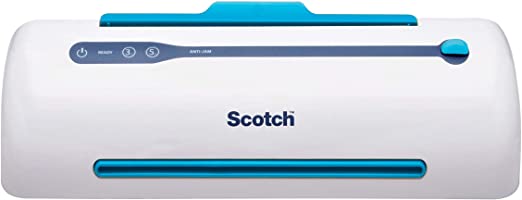
- Laminating film. The thickness of the plastic film doesn’t matter a lot, except for a few types of projects. For the most part, 3 mil film is great. It’s not so flimsy as 1 mil, but it will still bend if you are trying to do book-making or creating flashcards. If you want to create something that is better to not bend, like a dry erase graphic organizer or a full-page book cover that will have a spiral or comb-binding, then 5 mil film is better. The prices for laminating film are mainly based on the thickness. For most things needed in a homeschool, the thinnest film is adequate. I have found that order from Amazon, Oriental Trading Company, or ULine seem to have the best prices when ordering by the box. I order in bulk because the cost goes down drastically.
- 3-Ring Binder.
- I keep our homeschool records in a 3-Ring Binder and digitally. The hard copies are for having back-up copies and a place to put important work samples. I keep the digital files so they can be sent to medical providers or therapists by email as needed.
- We also created a yearly homeschool yearbook that was like a photo album scrapbook, where we also placed programs from performances and other memorabilia. I got several sets of three 1-inch binders to set up our yearbooks.
- File Folders.
- OK, for me file folders are a MUST because I make folder board games for phonics, vocabulary, and math, and other activities. I love to play games with my kids, and I love to make learning more effective and fun. I spend way less money, time, and frustration by making folder games that my kids will play many times than I could in printing out a ton of worksheets that my kids resist completing.
- I have also used file folders to make early childhood concepts matching activities and individual pocket charts for words and math facts. I’ve laminated them with boxes and lines on them for sight word spelling practice.
- File folders can also be a way to store handwriting paper, graphic organizers, timeline figures, and more. I put them in an open file box at my teaching station or on a bookshelf for easy access.
- Envelopes – 6×9 in and 11×13 in.
- I use the 6×9 envelopes to store game pieces for folder games. It tucks nicely into the folder and I have never had pieces fall out even if I don’t do the clasp.
- I use the 11×13 envelopes for other games that don’t have a folder game board. I mark on the front in a similar way as my folder game covers: The name of the activity, the skill, the level, and any other directions that may be needed.
- Copy Paper. I used to buy really cheap paper with 88 brightness. I use copy paper for kids to draw also, so I now get paper by the box with 92 brightness. It helps in balancing cost to quality. I mainly just pick up a box at Walmart, but certainly you can get it from other sources. Always, if you order things, watch the shipping costs because they can add up quickly.
- Electric Pencil Sharpener. Kids often make a huge mess with hand-held pencil sharpeners even if they have a cover. Sometimes they dawdle because it keeps them from doing those dreaded worksheets. I found that the Xacto Electric Pencil Sharpener has held up for many years. I’ve had 2 in our house for many years and have only needed to replace one.
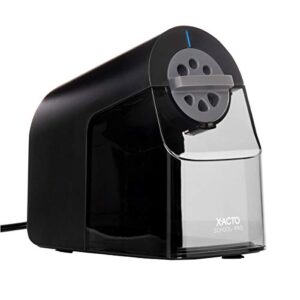
- Punches: 3-Hole, 1-Hole, 1” Circle, 1” Square. The 3-hole punch helps to put work in your 3-Ring binder or in student notebooks. The 1-hole punch is for fine-motor activities and craft projects. The 1” circle and 1” square are for all kinds of hands-on activities, art/craft projects, letters, numbers, labels, etc. Get bigger circle and square punches if you find you use them a lot!
- Stapler. This is just a basic office supply, but it can also be a good fine motor strengthening tool.
- Post-It Notes. I’m not a crazy post-it note lady, but I still use them for marking places, writing out spelling words for my kids with dyslexia, making to-do lists, etc.
- 3×5 Index Cards. I think this was on my student list also, but I truly go through hundreds of 3×5 index cards a year, so I thought I would add it here again. I would have a hard time teaching phonics and math without plenty of index cards!
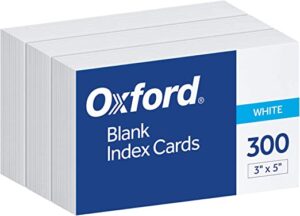
- Thumb Drive or External Hard Drive. I make a lot of files. If you do too, this helps to keep your homeschool files in one place and take it on-the-go. If you don’t, inexpensive thumb drives can be helpful for your older students to keep a writing portfolio (of course, Google Docs and Drive are helpful also).
- A Light Box. I’ve used a light box for many years for making my games. For the kids, a light box helps for tracing and art activities. I recently found this very cool Light Pad, a back-lit clipboard type of tracing board that is way less bulky than a box. If your older kids are planning to go into any kind of major that requires design, they will use this a lot.
- Cricut Machine. A Cricut machine is a die cutting device that can create many shapes out of paper or other materials. It certainly isn’t an essential, and it’s pretty expensive for a homeschool mom device. However, if you are crafty and create early childhood activities or do paper crafts, a Cricut Machine can be very useful in making your homeschool a hands-on fun time for your kids!
- A Magnetic Dry Erase Board. I have a large magnetic whiteboard for the wall and a lap sized for each kid. I use it differently than in a classroom, but we do phonics and spelling, grammar, handwriting, math, and anything that needs planning on the large board. For me, I no longer buy a regular whiteboard, but get a magnetic one always because there are so many more things we can do with it.
- Dry Erase Markers, Eraser, and Board Cleaner Spray
- Push Pins, Paper Clips, Binder Clips, Rubber Bands – Get colored paper clips to double as math manipulatives and to use for fine-motor activities.
- Tape. Clear packing tape for book making and fixing stuff. Scotch tape for small projects and fixing stuff. Painters tape for floor activities, art projects, color-coding (yes, you can get color-coded teacher tape that is like painters tape), and of course, fixing stuff.
- Flair Marker Pens. I love Flair Marker Pens! I also love fine point Sharpie markers. I love markers of any kind!
- Composition Notebooks or Blank Books – I use composition notebooks and blank books for journals, making assignment lists, writing my own to-do-lists, and for lots of book-making activities for projects in any subject area.
Teaching Supplies
- Homeschool Planner.
- I used to create my own because I did individual plans for the skills areas and a group plan for content subjects. I tailored my homeschool planner with my own kids’ names and the program titles we were using. It tended to cost me about $25 per year, but it made all the difference in knowing where we were headed from week to week and month to month. As the older ones graduated, I had one in high school grades and one in elementary. I started buying two cheap teacher lesson plan books.
- A Laptop or Desktop Computer. I have my own computer, and kids don’t touch it. When our kids entered high school, they each got a basic laptop or Chromebook for doing research and writing.
- Wall Maps. I always have a world map and a USA map on a wall. The dollar store usually has a decent version of both. If you can, order one pre-laminated because the lamination is better quality and less expensive than going to an office supply store to use a large laminator. For elementary through high school, a laminated map can be marked on with a dry erase marker or a vis-à-vis overhead marker, which makes learning geography more effective.
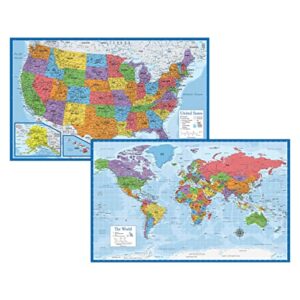
- Globe. A globe is a nice addition for social studies, but it isn’t an essential. An GeoSafari Talking Globe for older kids is great for independent learning. We used ours quite a bit, which is why I list it.
- A Wall Calendar. When the kids were young, I used teacher calendars and changed them each month. As the kids got older, we used various wall calendars and color-coded activities for each person.
- A Sand Tray and a Rice Tray. A rice tray is the easiest to make because most homes have the supplies already on hand.
- Magnet Letter Tray. I use dollar store cookie sheets with letters I made. Nearly every multisensory phonics program has their own letters to print, laminate, and put a magnet on the back of each letter.
- Letter and Number Rubber Stamps and Colored Stamp Pads. I love using letter rubber stamps and number rubber stamps with kids who have fine motor issues. The activities are fun and can be color-coded by using colored stamp pads.
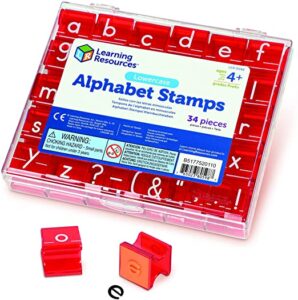
- Microscope. You can find decent high school microscope at the Home Science Tools website. You can also get hand-held microscopes with a light for outdoor exploration, or jeweler’s loupes for study of tiny things and making detailed drawings.
- Other Science Equipment. Your science program will likely have a list of materials at each grade level. However, some of the items I keep on hand are: a thermometer, magnets for playing, safety mirrors, a weight scale, measuring cups (kitchen ones are fine), small cups or bowls for mixing things, hot wheels cars, and a flashlight.
- Art Supplies. Sketchbooks are great for older students. Other supplies might include: artist chalks, oil pastels, clay, model magic, scrapbooking papers, cardstock papers, special craft scissors, polyurethane, wood blocks or items, plastic laces, yarn, rubber stamps, embossing powders, jewelry beads, and so many others!
- Bean Bags.
- Small Obstacle Course Cones.
- Jump Ropes.
- Parachute.
- Balls of Various Styles and Sizes.
- Rulers.
- Basic Calculators. We use both Texas Instruments TI-30Xiis and Casio FX-82MS
- Protractor and Compass.
- Kindle or Tablet or IPad – Some kind of e-reader and listening device is helpful if you are on-the-go a lot.
- Headphones or Earbuds.
- Library Card. – Depending on your local library, you may save a lot of money checking out books according to your theme units and lit lists. We can also check out audiobooks, videos, and other media. Our library also has culture passes, where we can get free admission to many museums in our area! For our lit books, I often buy them to put in a book basket, and then they become treasures that we just can’t get rid of!
- Math Manipulatives. – Before launching into purchasing any math manipulatives, decide on your curriculum and consider buying whatever kit comes with that program. However, if you are teaching a unique learner, you will absolutely need Base 10 Blocks. Other math essentials (in my opinion) are green and red counters, playing cards (or special math number cards), attribute blocks, pattern blocks, craft sticks, wooden blocks, Legos, and a bucket balance.
- Puzzles and Games. I find large floor puzzles, games, and learning toys at thrift stores and garage sales. I seldom order new unless I know specifically that a particular puzzle or game will be used multiple times.
- Puppets and Rhythm Instruments.
- Puppets are a wonderful way to do language and communication skills in early childhood and primary grades. Puppets promote collaboration and cooperation. They help kids sequence and build stories.
- Puppets may seem like something for early childhood only; however, sometimes an upper elementary kid with communication issues will often give an oral report or share their knowledge by talking through a puppet. Older students may be given an assignment to share information with younger kids by creating a puppet skit and adjust their knowledge to communicate with a different audience.
- Rhythm instruments are awesome for early childhood and primary grades. They are also great for integrating coordination between fine motor and large motor skills. Rhythm instruments can be a fun side therapy activity if a child is doing OT or other cognitive training program for sensory integration.
Start with the basic supplies you know you will need. Don’t go overboard. Many teacher-type of supplies may go on sale during back-to-school season. Watch for office supplies to go on sale.
Watch for my course for the 6-steps for How to Plan a Homeschool for Kids with Special Learning Needs, which will be launched in July 2022! This first course goes more in-depth on planning a homeschool year based on the free Learning Plan Success Kit. I will also be posting videos and articles about how to use many of the items on this list and from the student supply list to make learning multisensory and fun! If you want to receive updates on what is happening in the Unique Learners community, follow us on social media.
